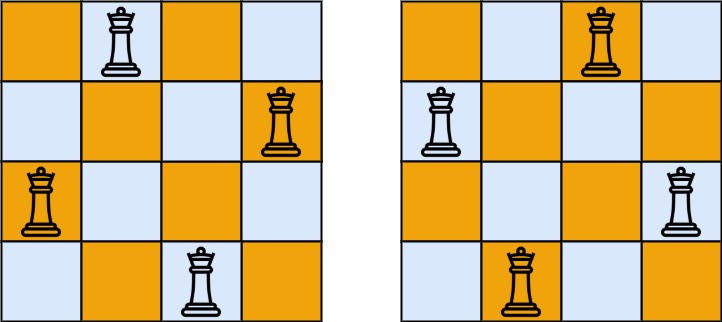51.n-queens
Statement
Metadata
- Link: N 皇后
- Difficulty: Hard
- Tag:
数组回溯
n 皇后问题 研究的是如何将 n 个皇后放置在 n×n 的棋盘上,并且使皇后彼此之间不能相互攻击。
给你一个整数 n ,返回所有不同的 n 皇后问题 的解决方案。
每一种解法包含一个不同的 n 皇后问题 的棋子放置方案,该方案中 'Q' 和 '.' 分别代表了皇后和空位。
示例 1:

输入:n = 4
输出:[[".Q..","…Q","Q…","..Q."],["..Q.","Q…","…Q",".Q.."]]
解释:如上图所示,4 皇后问题存在两个不同的解法。
示例 2:
输入:n = 1
输出:[["Q"]]
提示:
1 <= n <= 9
Metadata
- Link: N-Queens
- Difficulty: Hard
- Tag:
ArrayBacktracking
The n-queens puzzle is the problem of placing n queens on an n x n chessboard such that no two queens attack each other.
Given an integer n, return all distinct solutions to the n-queens puzzle. You may return the answer in any order.
Each solution contains a distinct board configuration of the n-queens' placement, where 'Q' and '.' both indicate a queen and an empty space, respectively.
Example 1:

Input: n = 4
Output: [[".Q..","…Q","Q…","..Q."],["..Q.","Q…","…Q",".Q.."]]
Explanation: There exist two distinct solutions to the 4-queens puzzle as shown above
Example 2:
Input: n = 1
Output: [["Q"]]
Constraints:
1 <= n <= 9
Solution
#include <bits/stdc++.h>
#include <ext/pb_ds/assoc_container.hpp>
#include <ext/pb_ds/tree_policy.hpp>
#define endl "\n"
#define fi first
#define se second
#define all(x) begin(x), end(x)
#define rall rbegin(a), rend(a)
#define bitcnt(x) (__builtin_popcountll(x))
#define complete_unique(a) a.erase(unique(begin(a), end(a)), end(a))
#define mst(x, a) memset(x, a, sizeof(x))
#define MP make_pair
using ll = long long;
using ull = unsigned long long;
using db = double;
using ld = long double;
using VLL = std::vector<ll>;
using VI = std::vector<int>;
using PII = std::pair<int, int>;
using PLL = std::pair<ll, ll>;
using namespace __gnu_pbds;
using namespace std;
template <typename T>
using ordered_set = tree<T, null_type, less<T>, rb_tree_tag, tree_order_statistics_node_update>;
const ll mod = 1e9 + 7;
template <typename T, typename S>
inline bool chmax(T &a, const S &b) {
return a < b ? a = b, 1 : 0;
}
template <typename T, typename S>
inline bool chmin(T &a, const S &b) {
return a > b ? a = b, 1 : 0;
}
#ifdef LOCAL
#include <debug.hpp>
#else
#define dbg(...)
#endif
// head
class Solution {
public:
int n;
vector<vector<string>> res;
vector<string> toString(const vector<vector<int>> &g) {
auto cur_res = vector<string>();
for (int i = 1; i <= n; i++) {
string s = "";
for (int j = 1; j <= n; j++) {
if (g[i][j]) {
s += "Q";
} else {
s += ".";
}
}
cur_res.push_back(s);
}
return cur_res;
}
bool ok(int x, int y, const vector<vector<int>> &g) {
for (int i = 1; i <= n; ++i) {
for (int j = 1; j <= n; ++j) {
if (!(x == i && y == j)) {
if (g[i][j] == 1) {
if (i == x)
return false;
if (j == y)
return false;
if (i + j == x + y)
return false;
if (i - j == x - y)
return false;
}
}
}
}
return true;
}
void dfs(int cur, vector<vector<int>> &g) {
if (cur == n + 1) {
res.push_back(toString(g));
return;
}
for (int i = 1; i <= n; ++i) {
if (ok(cur, i, g)) {
g[cur][i] = 1;
dfs(cur + 1, g);
g[cur][i] = 0;
}
}
}
vector<vector<string>> solveNQueens(int n) {
this->n = n;
auto g = vector<vector<int>>(n + 1, vector<int>(n + 1, 0));
dfs(1, g);
return res;
}
};
#ifdef LOCAL
int main() {
return 0;
}
#endif
最后更新: October 11, 2023